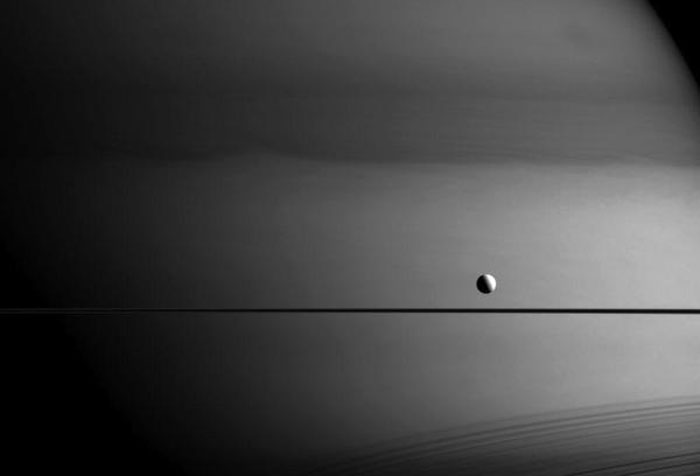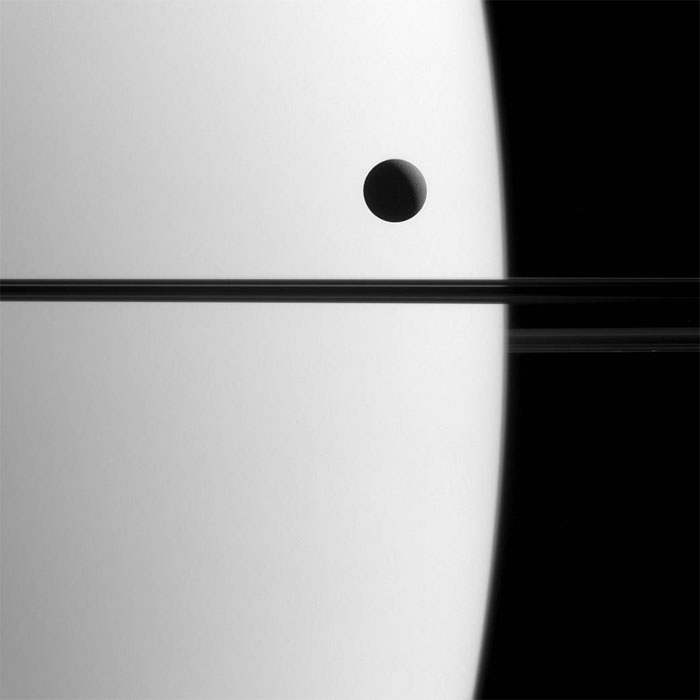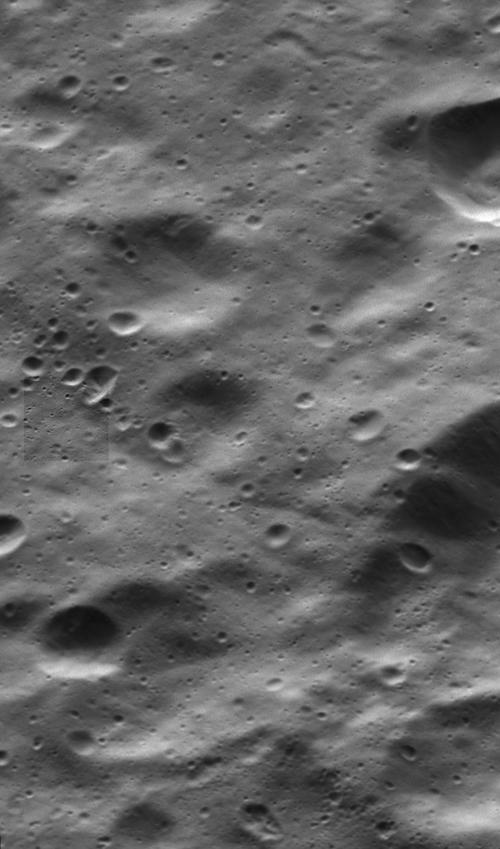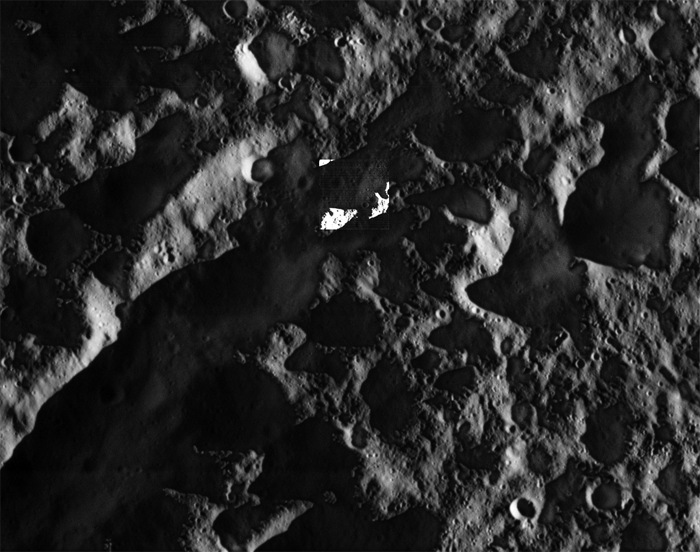.

Why does Saturn look like it's been painted with a dark brush in this infrared image, but Dione looks untouched? Perhaps an artist with very specific tastes in palettes?
The answer is methane. This image was taken in a wavelength that is absorbed by methane. Dark areas seen here on Saturn are regions with thicker clouds, where light has to travel through more methane on its way into and back out of the atmosphere. Since Dione (698 miles or 1,123 kilometers across) doesn't have an atmosphere rich in methane the way Saturn does, it does not experience similar absorption -- the sunlight simply bounces off its icy surface.
Shadows of the rings are seen cast onto the planet at lower right.
This view looks toward Saturn from the unilluminated side of the rings, about 0.3 degrees below the ring plane. The image was taken with the Cassini spacecraft wide-angle camera on May 27, 2015 using a spectral filter which preferentially admits wavelengths of near-infrared light centered at 728 nanometers.
The view was acquired at a distance of approximately 618,000 miles (994,000 kilometers) from Saturn and at a Sun-Saturn-spacecraft, or phase, angle of 84 degrees. Image scale is 37 miles (59 kilometers) per pixel.
.

Saturn's moon Dione crosses the face of the giant planet in this view, a phenomenon astronomers call a transit. Transits play an important role in astronomy and can be used to study the orbits of planets and their atmospheres, both in our solar system and in others.
By carefully timing and observing transits in the Saturn system, like that of Dione (698 miles or 1,123 kilometers across), scientists can more precisely determine the orbital parameters of Saturn’s moons.
This view looks toward the unilluminated side of the rings from about 0.3 degrees below the ring plane. The image was taken in visible green light with the Cassini spacecraft narrow-angle camera on May 21, 2015.
The view was acquired at a distance of approximately 1.4 million miles (2.3 million kilometers) from Saturn and at a Sun-Saturn-spacecraft, or phase, angle of 119 degrees. Image scale is 9 miles (14 kilometers) per pixel.
.

This two-in-one view of Dione from NASA's Cassini spacecraft includes the mission's highest-resolution view of the Saturnian moon's icy surface. The view, from the spacecraft's wide-angle camera (WAC), includes an inset view, near center left, from the narrow-angle camera (NAC). The NAC view (also available here at its full resolution) shows features about 10 times smaller than the WAC view. The wide-angle camera view has an image scale of about 105 feet (32 meters) per pixel; the narrow-angle camera view has an image scale of about 10 feet (3 meters) per pixel. Sunlight illuminates the scene from top. North on Dione is down. The views were acquired in visible light at an altitude of 334 miles (537 kilometers) above Dione.
The images were acquired simultaneously during a close flyby of the icy moon on Aug. 17, 2015. The views were obtained near the time of Cassini's closest approach to Dione during the encounter, like PIA19654. Along with a view taken by Cassini in 2005 (see PIA07748). The NAC images in these two image releases are the highest resolution views of Dione's surface acquired by Cassini.
-

-

NAC Image
-
As NASA's Cassini soared above high northern latitudes on Saturn's moon Dione, the spacecraft looked down at a region near the day-night boundary. This view shows the region as a contrast-enhanced image in which features in shadow are illuminated by reflected light from Saturn. Inset just above center is a higher resolution view -- one of the mission's highest-resolution views of the Saturnian moon's icy surface.
Territory seen here is just east of a crater named Butes, near an unnamed tectonic structure around 65 degrees north latitude, 25 degrees west longitude.
The broader view is from the spacecraft's wide-angle camera (WAC) and includes an inset view from Cassini's narrow-angle camera (NAC). The NAC view (also available here at its full resolution) shows features about 10 times smaller than the WAC view. The unenhanced WAC view is also provided here.
The views were obtained near the time of Cassini's closest approach to Dione during the encounter, like PIA19653. The NAC images in these two image releases are the highest resolution views of Dione's surface acquired by Cassini.
The views were acquired in visible light at an altitude of 365 miles (588 kilometers) above Dione. The wide-angle camera image has an image scale of about 115 feet (35 meters) per pixel; the narrow-angle camera image has an image scale of about 12 feet (3.5 meters) per pixel.
Quelle: NASA
5356 Views
